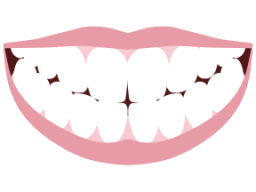How to get a perfect smile | instasmile snap-on veneers
Affordable solutions for a perfect smile
Your smile is a gift to the world. When you flash your pearlies at passers by and loved ones alike, the whole world smiles with you. A smile doesn’t just help others to feel better, it makes you feel better! Studies show that smiling releases endorphins- the brain’s feel good chemicals, helping to brighten your own day as you brighten others with your gorgeous grin. But if you’re self-conscious about your smile, you may be holding back from sharing it with the world. If you are worried about gaps in your teeth, as well as discolored or missing teeth you may have spent years holding back from sharing your smile with all but your most trusted loved ones.
This is a shame, as it can prevent you from looking and feeling your best, as well as denying you the natural endorphin that comes from sharing your smile. Over time, a lack of confidence in your smile can erode your overall confidence. You might even feel less able to enjoy yourself in the company of friends and family. Fortunately, as cosmetic dental treatments have become more sophisticated and widely available, many have regained that picture perfect Hollywood smile they’ve always dreamed of.
Still, while there are many cosmetic dental treatments available today, there are still many who are reluctant to take the plunge. Here we’ll look at the increasing popularity of cosmetic dental treatments, the most common treatments used to create a perfect smile and how the next step in their evolution may be crucial in helping those who have shied away from treatment to get the perfect smile of their dreams at an affordable price.
The rise and rise of cosmetic dental treatment
Cosmetic dentistry is nothing new. Since the days of ancient Rome people have been trying to whiten their teeth and beautify their smiles. Although, given that early toothpastes were made with human urine (containing ammonia- a natural whitening agent) we’re not surprised the Emperor Tiberius banned kissing!
Indeed, the Etruscans were making rudimentary dentures from bone and ivory, and the ancient Egyptians hammered sea shells into their gums to bridge the gaps between missing teeth. However, cosmetic dentistry as we know it first came about in the modern era (1950s onward). As cosmetic treatments made from metals and ceramics became safer, more sophisticated and more affordable, people from all walks of life were suddenly able to correct their longstanding dental gripes and smile with confidence once more.
The fact that cosmetic dentistry has been around for so many centuries speaks to the importance of our smile in defining our self-image and bringing us confidence. A perfectly straight and sparkling white beautiful smile is a great look on absolutely everyone and shows the world that we’re healthy, happy and confident.
Traditional cosmetic dental treatments
There are many reasons why people might want to correct their smiles with a cosmetic treatment dental care. They may wish to undo the discoloration caused by years of smoking or drinking coffee, tea and red wine. They may wish to fill the gap left by one or more missing teeth. Or they may wish to repair the appearance of a tooth that has become lost or damaged as the result of an accident.
Over the years, the dental industry has responded in kind, bringing a wide range of treatments to restore the self confidence of their wearers. Check out some of their pros and cons...
Crowns
Crowns are used to cover teeth which have become damaged. They are often used if a tooth is chipped or cracked in an accident. Even if a cracked tooth is still whole, a crown can help prevent the tooth from being damaged further. Likewise if a tooth has a lot of cavities and fillings, a crown can lend it the strength that it has been lacking preventing further damage. A crown is a tooth-shaped prosthetic that sits over the tooth- the enamel of which is usually filed down to accommodate the crown. If a tooth is seriously damaged, it may be secured in place with a titanium steel post.
Crowns are usually made from metals, ceramics, resin or porcelain fused to metal. They can help restore even heavily damaged teeth to their former beauty. They tend to last around 15 years but when properly cared for they can last as long as 25-30 years.
Implants
Crowns are useful when a tooth is damaged, but when a tooth is lost altogether, an implant may be the best way to fill the gap in a way that looks natural and lasts a lifetime. Dental implants require a steel post to be drilled deep into the bone beneath the gum. Atop this sits a dental crown. This is a very time consuming procedure and usually takes several months. It’s also potentially very expensive, with costs usually ranging from $1,000- $3,000 per implant. This can add up quite significantly if you have several teeth that need to be replaced. Again, the crown can last anywhere from 15-30 years and the implant itself lasts a lifetime.
Dentures
Dentures offer a non-invasive alternative to dental implants and crowns. They can also be much more cost-effective for those who are missing a number of teeth. They fit over the gums and are attached with an adhesive. They are worn throughout the day and taken out at night before going to bed. Dentures do, however, come with caveats. They can take some getting used to, especially when talking or eating. What’s more, they can lead to excessive salivation and irritation of the gums.
Bridges
Bridges are false teeth called pontics which are put in place to bridge the gap between teeth where a tooth is missing. They are attached via crown abutments on the surrounding teeth and not to the gums or bones. As such, they are minimally invasive and very cost-effective. They can give natural looking results but can also be risky. If the crown abutments are ill fitting bacteria can collect in them and increase the risk of gum disease. Crowns can also change the structure of the teeth and bite, resulting in disproportionate wear, pain or even damage to the teeth.
Veneers
Finally, veneers are similar to crowns in that they improve the appearance, shape length or surface of teeth. Unlike crowns, however, they only fit on the front of the tooth rather than the whole thing. They are made of strong but extremely thin tooth colored porcelain, usually about 1mm thick. Around half as thick as a crown. The tooths surface enamel is removed to accommodate the veneer so they’re only suitable for teeth with a thick amount of enamel. Be warned, removing enamel can result in in your teeth being senstive to hot or cold liquids.
Why many people choose not to get cosmetic dental treatments
While, as we can see, there are a lot of options available, they all have their caveats. As such, many may choose to eschew a cosmetic dental treatment for fear of cost or discomfort or (if you’ll pardon the pun) teething problems as they get used to their new teeth.
However, as technology has moved forwards a new solution has become available.
The instasmile process
Ordering your custom smile from the comfort of your own home couldn’t be easier.
- Click the ‘Get Started’ button at the bottom of this page to check your eligibility for instasmile with our smile assessment
- Answer a few questions about your smile & we’ll check if you’re suitable
- Choose your shade & place your order - we offer 0% payment plans if you want to spread the cost
- We’ll send out an impression kit for you to use at home - make sure you watch our video guide.
- Send your impression back to us so we can create your custom partial denture alternative
- We will then: check, scan, design, manufacture and hand finish your product for beautifully naturally aesthetics
- Receive your custom veneers direct to your door and get really to smile with confidence again!
The next step in the evolution of cosmetic dentistry
Clip on veneers are more secure and easy to adapt to than dentures. The look that they provide is far more natural and realistic than temporary “flipper” teeth. And they’re unlike traditional veneers, crowns and implants in that they require no surgery. In fact, you don’t even need to step foot inside your dentist’s office.
The advent of clip on veneers has created a glimmer of hope for those who have been holding off on a cosmetic dental procedure because they were worried about pain, discomfort, high costs or needing to wait the better part of a year to see the final result.
Here are some of the biggest advantages of clip on veneers
Perfect for a variety of use cases
If you have broken or missing teeth, clip on veneers are suitable for you. If you’re worried about stained or discolored teeth, clip on veneers are suitable for you. If your teeth are gappy or crooked, clip on veneers are suitable for you. If you need teeth contouring or teeth reshaping, they’re suitable for you.
In fact, they’re suitable for just about anyone who isn’t happy with their teeth.
Quick and easy
Getting fitted for clip on veneers is far quicker and easier than most common cosmetic dental treatments and is a perfect substitute for braces, dental implants and other dental cosmetics. It’s as easy as;
- Receive your impression kit
- Take your impressions (the video below will show you how)
- Send your impressions away
- Get your custom made clip on veneers direct to your door in as little as 2-3 weeks.
No waiting for digital scans or for your gums to heal around painful implants. You don’t even have to step foot in a dentist’s office. Something that will bring peace of mind to the 30-40 million Americans who experience fear and anxiety at the thought of going to the dentist’s office.
Affordable
Finally, clip on veneers are extremely affordable compared to other treatments.
So, what are you waiting for? Join the cosmetic dental revolution and get your perfect smile in just a few short weeks!
Are you ready for your affordable smile transformation with no surgery and no dentist visits?
Click below to get started and see if you're suitable!
GET STARTED







 UK
UK
 USA
USA
 Australia
Australia
